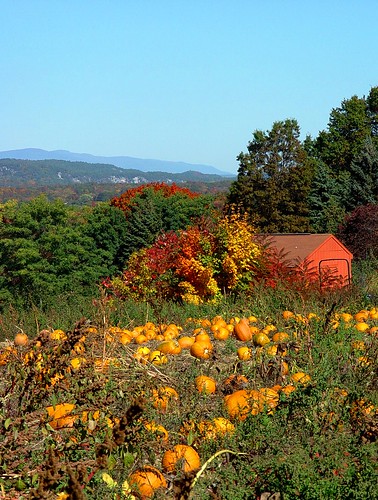As the moon waxes full over the scattered frost of the yard during these crisp October mornings, one's mind wanders to the warm colors and spicy flavors of Autumn. In the United States, the pumpkin is the quintessential element of Fall decorating and baking. But why limit our gourd to pies and lanterns one time each year? Our ancestors found a multitude of uses for this versatile plant.
| Gathering Pumpkings: An October Scene in New England, ca. 1860 |
Pumpkins, like many of our favorite vegetables, originated in North America and cultivated by American Indians for thousands of years. Prehistoric peoples created two lineages of the gourd; one was grown in Mexico, and the other, considered a subspecies by some, along the east coast of the United States. The pumpkin was roasted over fire, and pieces were pounded into strips to create mats.
Pumpkins prefer warm, moist environments, and the first Spanish explorers likely encountered them in Florida and Central America. They named them calabaza, and by the early 1700s both black and white farmers around St. Augustine, Florida, were actively growing them (may have been as early as late 1500s).
The English settlers brought with them to the New World their custom of carving squash into lanterns. These settlers, both Spanish and English, consumed pumpkin raw, roasted, cooked in a stew or soup. Some of the first European colonists filled the pumpkins with honey, cream and spices, then set them in the fire to cook. This may be the origin of pumpkin pie. During the late 1700s and early 1800s, New England farmers fattened cattle, hogs and horses on pumpkins during the winter, though they advised to place some salt on the flesh first, otherwise the animals may not find it appetizing.
| La Récolte des citrouilles à la Bastide de Malvalat by François Marius Granet (1775-1849), 1796 |
Instead of pottage and puddings and custards and pies,
Our pumpkins and parsnips are common supplies;
We have pumpkins at morning and pumpkins at noon,
If it was not for pumpkins we should be undone.
Poem from 1630, published in the Collections of Massachusetts Historical Society, 1838
Medicinal uses:
- Pumpkin seeds have been used to rid children of intestinal worms, and indeed the amino acid in the seed inhibits growth of immature liver flukes.

- In a 2007 study, pumpkin was found promote regeneration of damaged pancreatic cells.
- The seeds also contain omega-3 fats and zinc, which may promote prostate health.
Here's my recipe for simple pumpkin soup. Feel free to share your own pumpkin recipe.
2 cups cubed fresh pumpkin
1 tsp. salt
1 tbsp. sugar
1/4 tsp. nutmeg
1/4 tsp. ground pepper
3 cups chicken broth
1/2 cup fat free half and half.
I cook the pumpkin in a pan (to soften it), then place all the ingredients in a blender (I'm sure a food processor works as well). I then return it to the pan to continue simmering for about 20 minutes. Some people pour the soup back into the pumpkin and bake for a little while - it keeps the soup warm.
Most of my sources are from the 17th, 18th and 19th centuries, and are a fascinating read for those interested in the history of our country's agriculture.
mmm...pumpkin...I had the most awesome pumpkin soup last winter. I'll have to get the recipe and share it. It was fantastic. :)
ReplyDelete~Shawna
Your post is really good.
ReplyDeleteVery interesting blog. Alot of blogs I see these days don't really provide anything that I'm interested in, but I'm most definately interested in this one. Just thought that I would post and let you know. yatak odası dekorasyonu
ReplyDeleteI found your this post while searching for information about blog-related research ... It's a good post .. keep posting and updating information. Check the best green kratom strains.
ReplyDeleteGreat articles and great layout. Your blog post deserves all of the positive feedback it’s been getting. Loved to talk about the best affordable yachts.
ReplyDeleteThis blog website is pretty cool! How was it made ! its very great to talk about the best motor oil.
ReplyDeletePlease continue this great work and I look forward to more of your awesome blog posts. Love to talk about the best best football books.
ReplyDeleteHere, you make a valid argument!I wholeheartedly concur with what you've said!I appreciate you expressing your thoughts, and I hope this article gets viewed by more people. Adore discussing the greatest contact center workforce management.
ReplyDelete